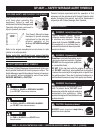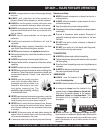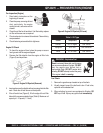
PAGE 12 — QP-402H CENTRIFUGAL PUMP — OPERATION AND PARTS MANUAL — REV. #1 (04/02/08)
QP-402H — GENERAL INFORMATION
APPLICATION
The
QP204H Centrifugal Pump
is designed to handle all types
of clear water applications. It is ideal for residential use such as
dewatering basements and swimming pools. Both the suction
and discharge ports on the QP-402H pump use a 4-inch diameter
opening, which allows the pump to pump at a rate of
approximately 425 gallons/minute (gpm) or 1,615 liters/minute
(lpm).
Centrifugal or self priming pumps are designed to purge air from
the suction line and create a partial vacuum in the pump body.
The reduced atmospheric pressure inside the pump allows water
to flow through the suction line and into the pump body. The
centrifugal force created by the rotating impeller pressurizes the
water and expels it from the pump.
Power Plant
This centrifugal pump is powered by either a Honda GX240K1
(8.0 H.P.) or a Honda GX240U1 (7.1 H.P.) air cooled 4-stroke,
single cylinder
gasoline engine that incorporates a low "Oil Alert
Feature."
Oil Alert Feature
In the event of
low oil
or
no oil
, the HONDA GX-240 engine has
a built-in oil alarm engine shut-down feature. In the event the oil
level is low the engine will automatically shut-down.
Standard Centrifugal Pump
Standard centrifugal pumps provide an economical choice for
general purpose dewatering. These types of pumps should only
be used in
clear water
applications (agricultural, industrial,
residential) as they have a limited solid handling capability of
only 10% by volume.
Suction Lift
This pump is intended to be used for dewatering applications
and is capable of suction lifts up to 25 feet at sea level. For
optimal suction lift performance keep the suction hose or line as
short as possible. In general, always place the pump as close to
the water as possible.
Pump Support
The pump should always be placed on
solid stationary
ground
, on a level position.
NEVER place the pump on
soft soil
. The suction hose or pipe
connection should always be checked for tightness and leaks. A
small suction leak in the hose or fittings could prevent the pump
from priming.
Elevation
Higher elevations will effect the performance of the pump. Due to
less atmospheric pressure at higher altitudes, pumps DO NOT
have the priming ability that they have at sea level. This is due to
the “thinner air” or lack of oxygen at higher altitudes.
A general rule of thumb is that for every 1,000 feet of elevation
above sea level a pump will lose one foot of priming ability.
For example, in Flagstaff, Arizona where the elevation is
approximately 7,000 feet, the pump would have a suction lift of
only 18 feet rather than the 25 feet at sea level. Table 3 shows
suction lift at various elevations.
Table 4 shows percentage drops in performance as elevation
increases.
suoiraVtassoLecnamrofreP.4elbaT
snoitavelE
edutitlA
sreteM(teeF
wolFegrahcsiDdaeHegrahcsiD
leveLaeS%001%001
)016(000,2%79%59
)912,1(000,4%59%19
)928,1(000,6%3
9%78
)834,2(000,8%19%38
)840,3(000,01%88%87
snoitavelEsuoiraVtatfiLnoitcuS.3elbaT
edutitlA
)sreteM(teeF
)sreteM(teeFnitfiLnoitcuS
leveLaeS)840.3(0.01)275.4(0.51)690.6(0.02)026.7(0.52
)016(000
,2)086.2(08.8)320.4(2.31)463.5(6.71)507.6(0.22
)912,1(000,4)773.2(08.7)665.3(7.11)457.4(6.51)349.5(5.91
)928,1(
000,6)301.2(09.6)961.3(4.01)602.4(8.31)372.5(3.71
)834,2(000,8)988.1(02.6)438.2(03.9)977.3(4.21)427.4(5.51
)840
,3(000,01)737.1(07.5)126.2(06.8)474.3(4.11)853.4(3.41


















